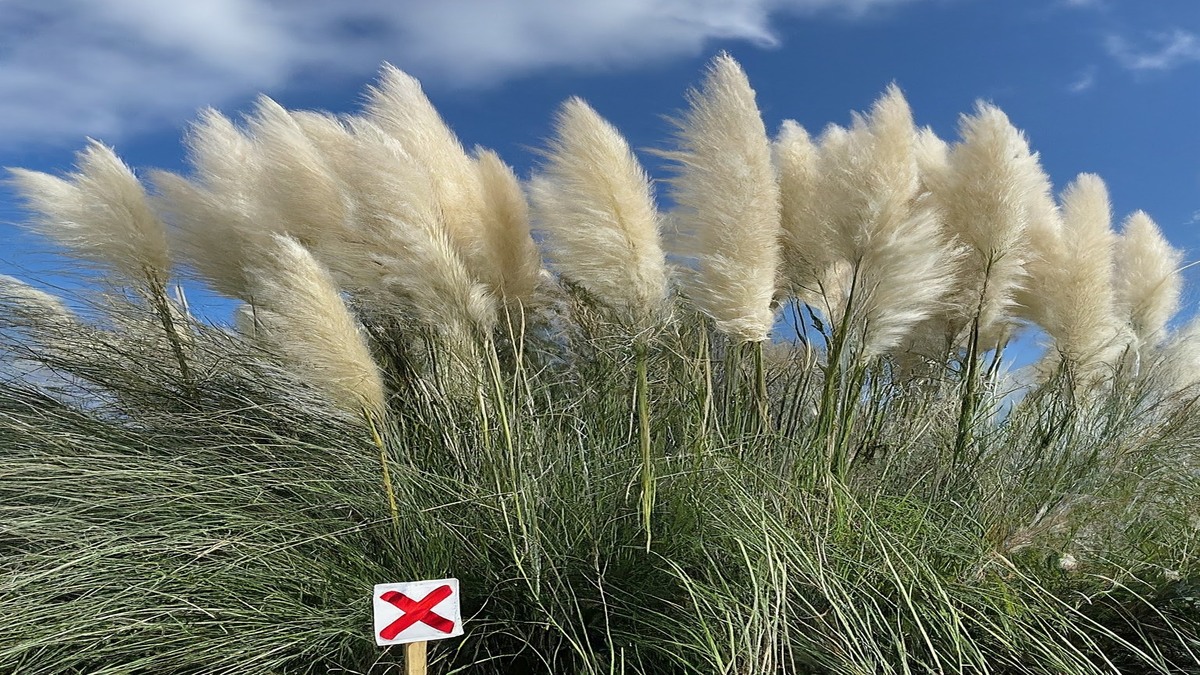What are the disadvantages of Pampas? However, while Pampas grass is aesthetically pleasing and offers several benefits such as creating a natural boundary and requiring minimal maintenance, it comes with several significant disadvantages. One of the major drawbacks is its invasive nature. It has a tendency to spread rapidly and can overtake surrounding vegetation if not properly managed. Removing it once established can be challenging and time-consuming due to its extensive root system and sharp leaves.
Environmental Impact of Pampas Grass
Pampas grass, scientifically known as Cortaderia selloana, is native to South America but has become an invasive species in several regions of the world. It can become invasive due to its ability to outcompete native plants for resources, leading to a loss of biodiversity. This happens because Pampas grass forms dense stands and monopolizes resources such as sunlight, water, and nutrients. This suppresses the growth of indigenous plant species, leading to a decline in biodiversity and ecological imbalance. Furthermore, Pampas grass is a fire hazard due to its dry foliage and high flammability.
Case Studies of Ecosystems Affected by Pampas Grass
- Southern Europe: A study conducted in Southern Europe revealed that Pampas grass can significantly change natural and semi-natural habitats by decreasing species richness, diversity, and plant cover, thereby threatening natural vegetation. The study also highlighted the role of public awareness and education in controlling the spread of this invasive species.
- Brazil’s Pampa Grassland: Nearly a third of the Brazilian portion of South America’s Pampa grassland has been lost since 1985, largely to agricultural expansion and forestry plantations. The original grassland ecosystems suffered an extreme transformation and have now almost completely disappeared. The expansion of agriculture may also be exacerbating an age-old problem in the Pampa, which is the spread of barren, sandy patches of land.
- United States: Pampas grass is considered invasive in some areas of the United States such as California, Hawaii, Texas, Oregon, and Washington. It displaces native plants and destroys their habitats, reducing biodiversity.
Maintenance Challenges of Pampas Grass
A. Maintenance Overview
Pampas grass, or Cortaderia selloana, is a fast-growing and hardy plant that requires minimal maintenance once established. It thrives in full sun to partial sun and in well-draining soil. It is drought-tolerant, meaning established plants should receive plenty of water from natural rainfall unless there is an extreme drought. However, new plants may need to be watered deeply right after planting.
B. Pruning and Disposal of Clippings
Pruning pampas grass is usually performed in late winter or early spring. Due to the plant’s sharp foliage, this task should be done with great care using gloves and a long-sleeved shirt. The pruned stalks and spent foliage should be properly disposed of to prevent disease carryover and clutter. Pampas grass trimmings can be composted, used as garden mulch, or disposed of as yard waste per local guidelines.
C. Long-term Maintenance Difficulties and Costs
Despite its low maintenance, pampas grass can present some long-term challenges. It grows quickly and readily self-seeds, which can lead to it overtaking other vegetation and becoming very hard to get rid of once planted. It’s also highly flammable, so it should be kept away from structures, outdoor cooking areas, or open flames.
In terms of costs, the main expenses associated with pampas grass are the initial purchase of the plant and the tools required for its maintenance (such as gloves, shears, and possibly an electric hedge trimmer for larger clumps). However, these costs are generally one-time or infrequent expenses. The ongoing costs of maintaining pampas grass are relatively low, as it requires little watering or fertilization.
Invasiveness of Pampas Grass
A. Rapid Spread of Pampas Grass
Pampas grass, or Cortaderia selloana, is known for its rapid and aggressive spread. It spreads primarily through its seeds and its extensive network of underground rhizomes. A single plant can produce a vast number of seeds, up to a million in a year, which are equipped with mechanisms that facilitate wind dispersal. This allows the seeds to travel far and wide before settling and germinating in new locations. The grass can propagate both naturally and via human intervention.
B. Methods to Control Its Spread and Their Challenges
Controlling the spread of Pampas grass requires proactive measures such as monitoring, removal of mature plants, and prevention of seed dispersal. However, these methods can be challenging due to the plant’s resilience and tolerance to different environmental conditions. Here are some common methods and their challenges:
- Herbicide Application: The best herbicide to use for pampas grass is glyphosate. However, it may take up to two weeks for the entire system to completely die, and the chemicals can be lethal if used improperly.
- Burning: In some areas, it may be legal to burn pampas grass to get rid of it. However, this method should only be used with extreme caution and with the proper permits and safety precautions in place.
- Manual Removal: Pampas grass can be dug up, but its hardy root systems often make this difficult.
C. Legal Considerations
In the United States, laws regarding plants, including pampas grass, vary from state to state. While there is no federal ban on pampas grass, some states and local municipalities have restrictions or outright bans on its planting and propagation due to its classification as an invasive species. For example, it’s considered invasive in California and Hawaii, and classified as a noxious weed in Washington and Oregon. In South Africa, Pampas Grass is regarded as an invasive species of serious concern. Residents who fail to comply with a contravention notice could be fined or sent to jail.
How to keep pampas grass from spreading?
Health and Safety Concerns with Pampas Grass
Physical Hazards
Pampas grass, despite its soft and feathery appearance, poses certain physical hazards. Its leaves are sharp and can easily cause cuts and scratches to unsuspecting gardeners or passersby. The grass blades, although they look soft and elegant, are stiff and have extremely sharp edges.
Allergic Reactions
Pampas grass can trigger allergic reactions in sensitive individuals. Symptoms can include sneezing, runny or stuffy nose, itchy, watery eyes, nasal congestion, scratchy throat, cough, wheezing or difficulty breathing, itchy skin or hives, fatigue, headache, sinus pressure, and dark circles under eyes.
Precautions
If you have pampas grass in your garden, there are several precautions you should take:
- Location: Avoid planting pampas grass too close to your home, anywhere you do not want views blocked, or where it could spread onto your neighbor’s property.
- Fire Safety: Pampas grass is highly flammable, so do not plant near a grill or other fire hazards.
- Protective Clothing: Wear protective clothing and heavy-duty gloves to prevent skin irritation or injury when handling pampas grass.
- Allergy Management: If you suffer from pollen allergies, start allergy treatments ahead of allergy season.
- Invasive Control: Pampas grass is invasive and can spread rapidly. Ask your local greenhouse about sterile plants, which will not self-seed.
Remember, pampas grass is a beautiful but potentially hazardous plant. Always handle with care and take necessary precautions to ensure safety.
Pest and Disease Problems with Pampas Grass
Common Pests
Pampas grass can be affected by a variety of pests. The most common pest that affects pampas grass is the caterpillar. Caterpillars can strip the leaves from the plant, causing significant damage. In some cases, entire plants may be killed. Caterpillars can be controlled with a variety of insecticides. Another pest that can affect Pampas grass is aphids. They can be dislodged with a strong water spray or controlled with insecticidal soaps or neem oil.
Diseases
Pampas grass is susceptible to several diseases, including powdery mildew and rust. It can also experience fungal infections. If you notice gray mold spots on your Pampas grass, it could be a sign of a particular fungus that frequently affects flowers and spreads quickly. Root rot can also occur, especially in conditions of constant humidity.
Impact on Plant Health and Garden Maintenance
These pests and diseases can have a significant impact on the health of the pampas grass and the overall maintenance of your garden. Discolored leaves, stunted growth, or wilting are signs of trouble. Ignoring these signs can lead to the death of your plant. Therefore, it’s crucial to address any issues promptly to prevent them from escalating and affecting the health of your plant. Regular monitoring, early detection, and prompt treatment are key to maintaining the health and beauty of your pampas grass.
Does Pampas Grass Attract Bugs?
Alternatives to Pampas Grass
List of Alternative Plants
If you’re looking for plants that provide similar visual appeal to Pampas grass, consider the following options:
- Feather Reed Grass (Calamagrostis x acutiflora)
- Switchgrass (Panicum virgatum)
- Chinese Silver Grass (Miscanthus Sinensis)
- Pink Muhly Grass (Muhlenbergia capillaris)
- Mexican Feather Grass (Nassella tenuissima)
- Blue Fescue (Festuca glauca)
- Green Fountain Grass (Pennisetum setaceum)
- Japanese Sedge Grass (Carex morrowii)
- Tufted Hairgrass (Deschampsia cespitosa)
- Dwarf Mondo Grass (Ophiopogon japonicus)
- Japanese Blood Grass (Imperata cylindrica)
- Dwarf Fountain Grass (Pennisetum alopecuroides)
- Purple Fountain Grass (Pennisetum setaceum rubrum)
Benefits of These Alternatives
These alternatives offer several benefits over Pampas grass:
- Adaptability: These plants are better adapted to soils, moisture, and weather than exotic plants like Pampas grass.
- Low Maintenance: They require fewer fertilizers and pesticides and use less water.
- Non-Invasive: Unlike Pampas grass, these alternatives are unlikely to escape and become invasive, thereby preserving natural habitats.
- Support Wildlife: These plants support wildlife by providing shelter and food for native birds and insects.
Tips for Selecting and Caring for These Alternative Plants
When selecting and caring for these alternative plants, consider the following tips:
- Choose the Right Plant: Each plant has its own unique requirements for sunlight, soil type, and water. Choose a plant that suits your garden’s conditions.
- Planting: Most of these grasses prefer full sun and well-drained soil. Some can tolerate partial shade.
- Watering: Water newly planted grass thoroughly and keep the soil uniformly moist.
- Fertilizing: Fertilize in early spring, early summer, and the beginning of fall during the first year. After the first year, fertilize only in early spring.
- Pruning: Cut back old foliage and flower stalks in late fall.
- Overwintering: Spread mulch around the base and cover with burlap in colder regions. Remove burlap in early spring.
- Companion Plants: Companion plants that complement these grasses include other ornamental grasses, perennials, and shrubs that share similar growing conditions.
Remember, the key to a healthy and beautiful garden is regular monitoring, early detection, and prompt treatment of any issues.
Conclusion
Pampas grass, while visually appealing, comes with a set of challenges. Its sharp leaves can cause physical injuries, and it can trigger allergic reactions in sensitive individuals. It’s also susceptible to pests like caterpillars and diseases such as powdery mildew. Moreover, it’s highly invasive and can quickly take over your garden if not properly managed.
FAQs:
Here are some frequently asked questions (FAQs):
- What are the physical hazards of Pampas grass? Pampas grass, also known as razor grass, has sharp edges that can easily cut unwary passersby. Its leaves are sharp and can cause physical injuries.
- Is Pampas grass invasive? One significant disadvantage of Pampas grass is its invasive nature. It has a tendency to spread rapidly and can overtake surrounding vegetation if not properly managed.
- What are the fire risks associated with Pampas grass? Pampas Grass is known to be a fire hazard in dry conditions. The dry, dried-out foliage of the plant can easily ignite and spread flames rapidly, potentially posing a threat to nearby structures and vegetation.
- Is Pampas grass difficult to remove? Another downside of Pampas Grass is the difficulty in removing it once it is established. Its extensive root system and sharp leaves can make the eradication process challenging and time-consuming.



Pingback: Why is Selling Pampas Grass Illegal? – graasy.com
Pingback: How to Prevent Pampas Grass from Spreading Too Much